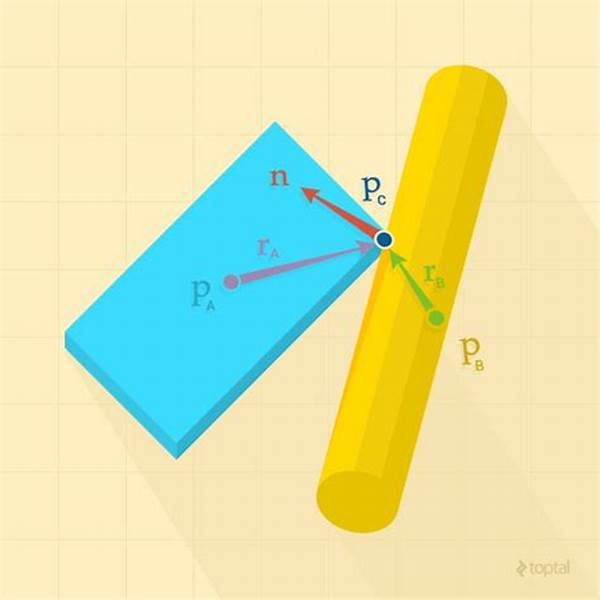Hey there, fellow tech enthusiasts! Today, let’s dive into the world of collision detection and figure out how to make it faster and smoother. Whether you are a game developer or working on a robotics project, optimizing collision detection performance is crucial. Imagine you’re in the middle of an epic game battle, and suddenly everything slows down because your system is struggling to calculate collisions. Not fun, right? So, let’s explore how to keep everything running without a hitch.
Read Now : Algorithm-based Animation Procedural Systems
Understanding Collision Detection
Collision detection is like the hidden traffic controller in your video game, ensuring that objects behave as they should without smashing through each other unexpectedly. But how do you go about optimizing collision detection performance? Well, it’s all about fine-tuning the algorithms and ensuring only necessary calculations are performed. From bounding boxes to spatial partitioning, there’s a whole toolbox of techniques at your disposal. Whether you’re dealing with 2D or 3D environments, understanding the intricacies of each method can be a game-changer.
When optimizing collision detection performance, you want to minimize the number of collision checks. This can be achieved by implementing strategies like broad-phase and narrow-phase detection. Broad-phase helps in eliminating pairs of objects that do not collide, while narrow-phase refines the detection process. As you continue to optimize, you will find that the right combination of techniques can lead to a snappier and more responsive system, leaving more room for those sweet graphical details or additional gameplay features.
Furthermore, leveraging hardware acceleration and parallel processing can revolutionize your approach to optimizing collision detection performance. Many modern GPUs are equipped to handle the heavy lifting, allowing for more complex interactions without sacrificing frame rates. As you explore these avenues, remember the key is to find a balance that works for your specific application. The goal is not just about throwing technology at the problem but rather understanding how each component contributes to a seamless experience.
Tips for Boosting Performance
1. Broad-Phase Techniques
Using broad-phase techniques such as spatial partitioning can efficiently eliminate non-colliding pairs early in the pipeline, making optimizing collision detection performance more manageable.
2. Narrow-Phase Detection
Focus your computing power on complex collision detection with narrow-phase strategies after eliminating unlikely collisions, thus optimizing collision detection performance.
3. Utilize Hardware Acceleration
Leverage the power of modern GPUs to handle collision calculations, greatly optimizing collision detection performance without overloading your CPU.
4. Bounding Volume Hierarchies
Implement bounding volume hierarchies to simplify collision checks and optimize collision detection performance by quickly ruling out non-collisions.
5. Continuous Updates and Testing
Keep optimizing collision detection performance by regularly updating your algorithms and rigorously testing under various conditions to ensure stability.
The Role of Algorithms
Diving into the nuts and bolts, algorithms play a pivotal role in optimizing collision detection performance. Algorithms such as AABB (Axis-Aligned Bounding Box) and OBB (Oriented Bounding Box) help encapsulate objects in simplified representations, making the detection process much quicker. By enclosing objects in these bounding boxes, systems can quickly determine potential collisions by quickly ruling out those that do not intersect.
Moreover, the integration of algorithms like the Sweep and Prune and the Separating Axis Theorem boost efficiency. Sweep and Prune sorts objects along an axis, reducing potential collision checks, while the Separating Axis Theorem easily detects possible collisions by testing for gaps along potential axes. Mastering these algorithms’ implementation can significantly benefit any developer’s efforts in optimizing collision detection performance.
Remember, the key to success in collision detection is understanding which algorithm best suits your project’s needs. Depending on the complexity and type of environment, different techniques will yield better performance. So, don’t be afraid to experiment with different methods and continually test to achieve optimal results.
Problem Solving Through Optimization
Every tech problem has a solution, and optimizing collision detection performance is no different. Visualize an intricate network of possible interferences and transitions among 3D objects. The challenge is to ensure smooth sailing without hiccups. The solution? Efficient algorithms and clever partitioning!
Read Now : Monetization Impact On Gaming Experience
Getting clever with pre-calculations and predictive modeling can dramatically enhance your project. Speed things up by reducing unnecessary computation wherever possible. While coding, think of the chain reactions, like ripples across a pond, ensuring initial computations make waves that optimize the downstream process.
Experiment, iteration, and adaptation play crucial roles in this journey of discovery and improvement. As your project scales, continuing to tweak and refine methods becomes increasingly important. It’s up to you to find those tiny, repeated tasks and streamline them to avoid performance bottlenecks, ultimately optimizing collision detection performance.
Common Mistakes to Avoid
Jumping into optimizing collision detection performance without proper research can lead to common pitfalls. One typical mistake is relying solely on brute force methods, which waste computational resources on unnecessary collision checks. Instead, dividing the problem into smaller components can help manage performance more effectively.
Neglecting to correctly implement broad-phase techniques can also slow down your system. Sometimes, developers underestimate the impact of using outdated hardware or misconfiguring acceleration features, both of which can hinder performance. Regularly revisiting these settings and updating your approaches are integral parts of maintaining optimal performance.
Finally, while optimizing collision detection performance, some developers might overlook the importance of ongoing testing. Continuously stress-testing your application under various conditions ensures you catch inefficiencies promptly, maintaining a smooth and enjoyable user experience.
Real-World Applications
Understanding the real-world impact of optimizing collision detection performance showcases its importance beyond theory. Whether in gaming, simulations, or robotics, efficient collision detection allows systems to perform optimally. For game developers, a seamless experience without lags enhances user engagement and satisfaction.
In simulations or robotics, precise calculations ensure accurate modeling, critical for operational efficacy and safety. These applications demand not only reliable performance but also quick adaptability. Optimizing collision detection in these fields ensures objects interact as expected, minimizing errors and enhancing real-time interaction fidelity.
Ultimately, the goal is to create an immersive, reliable experience, free from interruptions, by harnessing well-optimized collision detection performance. As we move forward, the advancements in technology will continue to rely heavily on these improvements to ensure immersive and engaging experiences.
The Future of Collision Detection
The horizon of collision detection holds tremendous promise, with innovations set to revolutionize the field. The quest for optimizing collision detection performance will benefit from emerging technologies like artificial intelligence and machine learning, which can anticipate multitudes of interactions far faster than traditional algorithms.
Leveraging such technology could allow dynamic adjustment of collision detection parameters, adapting in real-time to shifting demands. As virtual reality and augmented reality applications grow, they require equally advanced collision detection mechanisms—a task AI and machine learning can address.
As we dream boldly about the future, optimizing collision detection performance remains essential for making virtual environments richly interactive and intrinsically satisfying. Achieving this will require not only technological innovation but also a keen understanding of the principles that drive these systems.
Summary
In your quest for optimizing collision detection performance, remember that it’s as much about understanding limitations as leveraging cutting-edge technology. Starting with broad-phase techniques and refining through narrow-phase checks can lead to robust systems that handle collisions like a pro. Add a sprinkle of GPU acceleration and bounding volume hierarchies to keep everything running smoothly.
Avoid common pitfalls by steering clear of brute force methods and ensuring you implement efficient, up-to-date techniques regularly. Apply these strategies to real-world applications such as gaming, simulations, or robotics, where precise optimization significantly impacts performance and user satisfaction. Embrace the future of collision detection by staying informed and open to technological advancements.
As you continue navigating the world of collision detection, continual learning and adaptation are key. Don’t shy away from experimenting and refining processes. By doing so, you are paving the way for seamless, rich digital experiences, bringing the virtual world to life with impeccable detail and performance. Happy optimizing!




